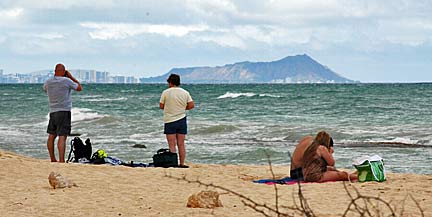City councilman

|
Delays prompt review
of plans for Kalaeloa
The uncertain future of a carrier
relocation leaves land empty
As the Pentagon considers relocating a nuclear aircraft carrier to Pearl Harbor, the state agency charged with planning the economic future of Kalaeloa has begun a $900,000 study to determine if its development plan for the area needs updating.
Except for a state general aviation airport, a Hawaii National Guard complex and a few light industrial companies, Kalaeloa, a once-bustling Navy air station in central Oahu known as Barbers Point, has been the victim of several hurdles to economic development, including substandard infrastructure and cloudy land ownership issues.
The 1993 Base Realignment and Closure Commission shut Barbers Point Naval Air Station, and the Navy officially turned it over to the state six years later. Since then the area has languished.
A May 3 federal Government Accountability Office study disclosed that fewer than 100 civilians work at an installation that once had a payroll of 680.
Stanton Enomoto, who was hired by the Hawaii Community Development Authority to oversee the development of Kalaeloa 10 months ago, acknowledged that part of the problem with redeveloping the area stems from the possibility that the Navy may reclaim Kalaeloa to base up to six dozen jet fighters and the helicopters crucial to a nuclear aircraft carrier, a possibility that did not exist when the base was closed in 1999.
"We don't want to do anything that would restrict the reuse of the area by the military," Enomoto added.
One crucial element that could help Enomoto in his quest to revitalize the 3,688 acres in Central Oahu is a $1.8 million internal Navy study that was started in the fall of 2003.
However, Navy officials have been reluctant to share the results from the study, which was done by Navy engineers to determine whether the piers, facilities and utilities can support a 1,092-foot carrier and the more than 6,000 sailors and aviators it would bring to Pearl Harbor.
A Pacific Fleet spokesman said the Navy hasn't completed the study and is "still examining a range of data and issues."
City Councilman Todd Apo, whose district encompasses the choice Ewa Plains real estate, said locating a Navy carrier wing "would be good to have. We need to revitalize the area. It's fantastic property."
Like U.S. Rep. Neil Abercrombie, Apo said he believes it will be imperative for the federal government to provide the necessary money to ensure that infrastructure in the area will be upgraded to support a carrier wing.
With a $900,000 planning grant, half of which comes from the state, Enomoto said his agency has commissioned a new economic study "to see if the assumptions that were made in the last study done in 1997 are still valid." That economic study is expected to be completed by September.
Of the 3,688 acres that made up Barbers Point, the Navy retained 1,000 acres, which includes a coveted golf course and portions of the white sand beach. There were 1,602 acres conveyed to the Coast Guard, Federal Aviation Administration, Fish and Wildlife Service, the Veterans Affairs, state and city agencies, but not all of the land was accepted by the new owners.
Still pending is the transfer of 485 acres to the city, including 168 acres of shoreline, for a regional park. There are major unresolved issues over upgrading roads and electrical, sewage, water and drainage systems.
Many of the zone changes proposed in 2002, including the development of a city regional park and the conversion of another 286 acres that would be used for commerce and recreation, were tabled because of the possible reuse of Kalaeloa by the Navy for a carrier strike group.
Enomoto acknowledged that planning Kalaeloa's future has been difficult, not only because of the uncertainty of the carrier, but also because the Navy didn't give the state the entire base and a popular 18-hole golf course. It retained control of 457 acres and turned over another 584 acres to a private developer as part of the plan to finance new Navy housing on Ford Island.
Enomoto points to Glenview Naval Air Station near Chicago as an example of economic success in reclaiming a former military base.
The former base is completing a $500 million redevelopment project that has created the Glen, an area designated for parks, housing and retail use.
The transformed base created 3,000 new jobs and will add 2,000. The airfield is now a golf course.
Military officials also like to point at the successes at Lowry Air Force Base near Denver.
Since 1994, residential and commercial redevelopment on the 1,800 acres of the former Colorado base have provided 3,000 homes for 6,500 new residents while creating about 6,000 jobs and generating a gross economic benefit of $4 billion for the Denver metropolitan area.
E-mail to City Desk
[News] [Business] [Features] [Sports] [Editorial] [Do It Electric!]
[Classified Ads] [Search] [Subscribe] [Info] [Letter to Editor]
[Feedback]
